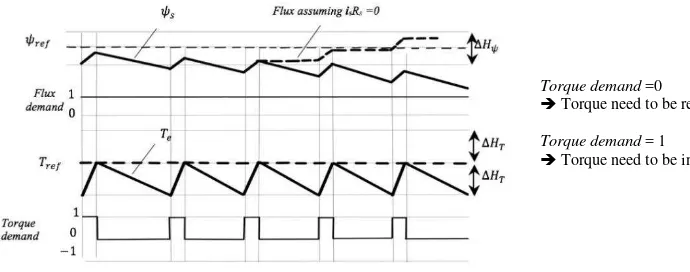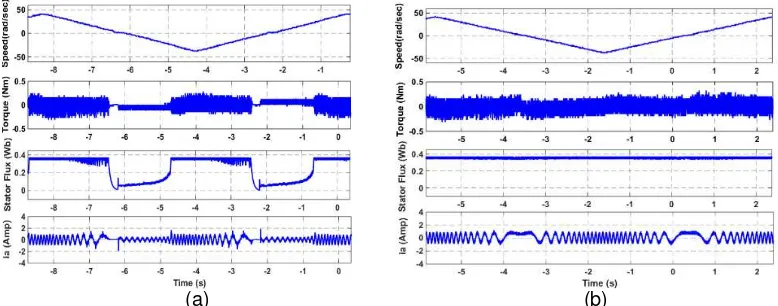TELKOMNIKA, Vol.15, No.1, March 2017, pp. 1~3
ISSN: 1693-6930, accredited A by DIKTI, Decree No: 58/DIKTI/Kep/2013
DOI: 10.12928/TELKOMNIKA.v15i1.5419 1
Received October 25, 2016; Revised December 14, 2016; Accepted Januari 16, 2017 Editorial
Direct Torque Control: Stator Flux Regulation
Improvement at Low Speed
Nik Rumzi Nik Idris
PROTON-UTM Future Drive Laboratory, Faculty of Electrical Engineering, Universiti Teknologi Malaysia, Skudai, Malaysia
Coreesponding author, e-mail: [email protected]
Abstract
A simple method to improve stator flux regulation of a direct torque control (DTC) of induction motor drive is presented. By using this method, the simple control structure of DTC is retained and no modification to the voltage vectors look-up table is required. To implement this technique, the index to the look-up table is modified so that the reverse voltage vectors are selected (instead of zero-voltage vectors) whenever the stator flux regulation fails. To study the viability and the effectiveness of this simple method in improving the flux regulation at low speed, experiments are conducted to a ¼ hp induction motor with DTC technique. The control algorithm is implemented using a DS1104 controller board with Xilinx FPGA.
Keywords: direct torque control, induction motor drive, flux regulation
Copyright © 2017 Universitas Ahmad Dahlan. All rights reserved.
Direct torque control of induction motor drives was introduced in mid 1980s by Takahashi [1] and Depenbrock [2]. Due to its simple implementation, yet excellence torque performance, it has picked up a lot of interest and has been considered as an alternative or replacement to the famous field oriented control (FOC). There are, however, several disadvantages which are normally associated with DTC drives that are based on its original structure as introduced in [1] and [2]; they are variable switching frequency, high torque ripple and stator flux regulation at low speed. To overcome these problems several variations of DTC were introduced, which can be generally be classified into two categories: Look-up table (LUT) based DTC and the Non-LUT based DTC. The implementation of non-LUT, typically, requires modulator, which is used to synthesize the reference voltages; these include the predictive dead-beat control, model predictive control or even artificial intelligent based control. On the other hand, in LUT based DTC, no modulator is required since the voltage vectors are selected from the look-up table depending on the torque and flux demands. The main advantage of the LUT based approach is its simplicity, i.e. the original structure of DTC as initially proposed in [1] and [2] is retained.
This short paper will briefly discuss on the problem of flux regulation in LUT based DTC, and subsequently presents a simple method that can be used to improve the flux regulation. The improvement is even more significant in sensorless drive system especially when stator flux is treated as one of the state variables used for the speed estimation algorithm [3]. The method can remove the problem of flux drooping, which normally occur at low speed operations, or when speeds are reverses. The implementation, as will be demonstrated, is very simple and does not require the modification to the simple structure of DTC.
Flux regulation problem
The flux regulation problem at low speed is caused due to the selection of zero voltage vectors used to reduce the torque [3]. In DTC, the change in flux is approximated by (1). Therefore, ideally, according (1), selecting zero voltage vectors will freeze the flux.
ISSN: 1693-6930
TELKOMNIKA Vol. 15, No. 1, March 2017 : 1 – 3 2
In practice, however, this is not the case; the flux decreases due to the stator resistance drop isRs. The flux regulation fails if the reduction of flux during the zero-voltage selection is larger than the increment in flux (during the active voltage vectors selections), as depicted in Figure 1. This condition normally occurs at low speed whereby the duration of the application of zero vectors is stretched. The regulation in flux therefore can be restored if, instead of zero vectors, active vectors are chosen to reduce the torque at low speed [3].
Figure 1. Flux Regulation Problem at Low Speed
Improving flux regulation
Based on the previous discussion, one of the simplest way to overcome the flux regulation problem is to change the index to the look-up table so that active voltage vectors are chosen instead of zero vectors whenever torque need to be reduced at low speed. Using this method, the look-up table need not to be changed. This can be implemented easily by using logic circuits, especially when the look-up table of the DTC is implemented using digital circuits such as field programmable gate arrays (FPGA). This logic circuit is placed before the look-up table and it will modify the torque index depending on the speed and stator flux error.
Experimental results
The DTC drive with the stator flux regulation improvement is implemented to a ¼ hp 3-phase induction motor. The control algorithm, including the flux regulation improvement, is realized using a dSPACE DS1104 controller board and a Xilinx FPGA device. The block diagram of the proposed drive, including the logic circuits (shown by the shaded block) is depicted in Figure 2. Other than the output of hysteresis comparator, the inputs to the logic circuits are the stator flux error and the sign of rotor speed.
TELKOMNIKA ISSN: 1693-6930
Direct Torque Control: Stator Flux Regulation Improvement… (Nik Rumzi Nik Idris) 3
The results shown in Figure 3 clearly indicated the improvement of flux regulation, which in turns improve the stator current harmonic contents. However due to the selection of the reverse vectors, the torque ripple is increased.
(a) (b)
Figure 3. Experimental Results (a) without Flux Regulation Improvement, (b) with Flux Regulation Improvement
References
[1] I Takahashi, T Noguchi. A new quick-response and high-efficiency control strategy of an induction motor. IEEE Transactions on Industry Applications. 1986; IA-22(5): 820-827.
[2] M Depenbrock. Direct self-control of inverter-fed induction machine. IEEE Transactions on Power Electronics. 1988;3(4): 420-429.

